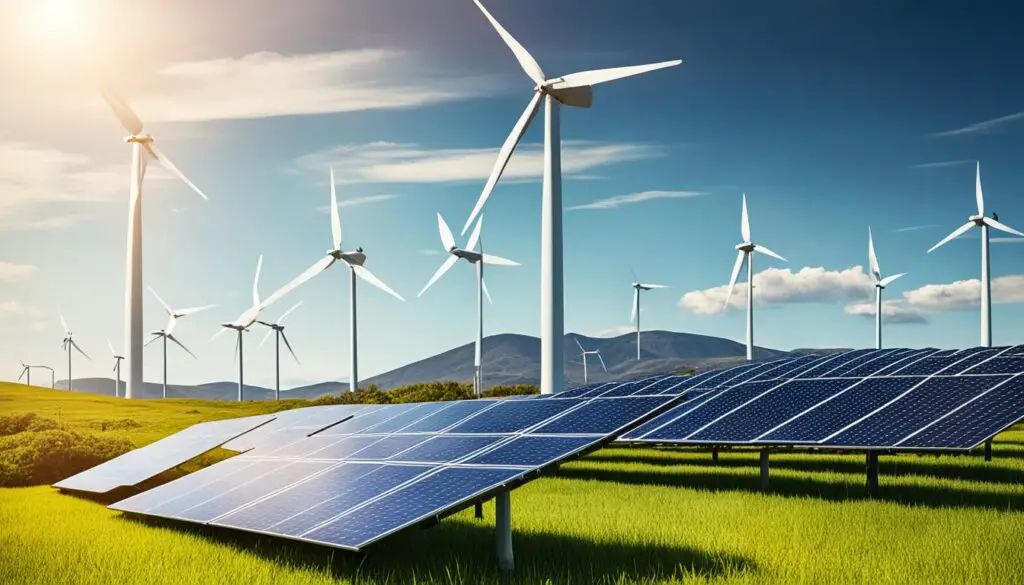As we strive towards a more sustainable future, the demand for clean energy continues to grow. One innovative solution that is transforming the clean energy industry is hybrid renewable energy systems. By combining different sources of renewable energy, such as wind and solar power, these systems offer maximum efficiency and pave the way for a greener future.
Key Takeaways:
- Hybrid renewable energy systems combine various sources of renewable energy to achieve maximum efficiency.
- They offer increased energy reliability, reduced greenhouse gas emissions, and cost savings.
- Components of hybrid renewable energy systems include wind turbines, solar panels, energy storage systems, and power converters.
- These systems have a wide range of applications, particularly in off-grid and remote areas.
- Hybrid renewable energy systems are a game-changer in the clean energy industry, paving the way for a more sustainable future.
What are Hybrid Renewable Energy Systems?
Hybrid renewable energy systems are the next generation of clean power solutions. They are designed to maximize efficiency by combining various sources of renewable energy, such as wind, solar, and hydro. These systems offer a sustainable and cost-effective approach to electricity generation, harnessing the strengths of each energy source and compensating for any fluctuations or variations in availability.
By integrating multiple renewable energy sources, hybrid systems create a reliable and resilient energy infrastructure. This combination not only enhances efficiency but also improves the reliability of the overall energy system. In contrast to relying solely on a single energy source, hybrid renewable energy systems ensure a consistent power supply even when certain sources experience temporary limitations.
The integration of renewable energy sources into hybrid systems brings numerous benefits. It reduces reliance on fossil fuels, which contribute to greenhouse gas emissions and climate change. Additionally, hybrid systems contribute to the diversification of energy sources, decreasing vulnerability to disruptions in supply and price fluctuations associated with traditional energy sources.
“Hybrid renewable energy systems offer a sustainable and cost-effective approach to electricity generation, harnessing the strengths of each energy source and compensating for any fluctuations or variations in availability.”
Furthermore, these systems promote energy independence, particularly in off-grid and remote areas where access to traditional power grids may be limited. By leveraging the combination of renewable energy sources, hybrid systems can provide a reliable and continuous power supply, offering opportunities for economic development and improved living conditions in underserved regions.
The table below illustrates the key components commonly found in hybrid renewable energy systems:
| Component | Description |
|---|---|
| Wind turbines | Convert wind energy into electricity. |
| Solar panels | Convert sunlight into usable energy. |
| Energy storage systems | Store excess energy for later use when renewable sources are not available. |
| Power converters | Ensure compatibility and efficient energy transfer between different sources and the power grid. |
These components work together seamlessly, creating a reliable and efficient hybrid system that maximizes the utilization of renewable energy sources.
Hybrid renewable energy systems are transforming the landscape of clean power generation. By combining multiple energy sources, these systems offer a more sustainable and resilient approach to meeting our energy needs. In the next section, we will explore the benefits of hybrid renewable energy systems in more detail.
Benefits of Hybrid Renewable Energy Systems
Hybrid renewable energy systems offer several compelling benefits, making them a valuable solution for clean power generation:
1. Increased Energy Reliability
By combining different energy sources, hybrid renewable energy systems provide a more stable and reliable power supply. This is especially important in areas with variable weather conditions, where one energy source may be more abundant while another experiences fluctuations. The combination of renewable sources ensures a continuous flow of clean energy, reducing the risk of power interruptions and improving energy reliability for consumers.
2. Reduced Greenhouse Gas Emissions
One of the key advantages of hybrid renewable energy systems is their ability to significantly reduce greenhouse gas emissions. Renewable energy sources, such as wind and solar, do not release harmful pollutants into the atmosphere during power generation. By replacing fossil fuel-based energy with clean and sustainable sources, hybrid systems contribute to mitigating climate change and protecting the environment.
3. Cost Savings
Hybrid renewable energy systems can help reduce energy costs over the long term. By relying on renewable sources, which are abundant and widely available, these systems decrease dependence on traditional energy sources that may be subject to price fluctuations or limited availability. Additionally, as renewable energy technologies continue to advance, the cost of implementing hybrid systems is becoming more competitive with conventional power sources, ultimately leading to cost savings for consumers.
Overall, hybrid renewable energy systems offer a range of benefits that contribute to clean power generation, enhanced energy reliability, reduced environmental impact, and long-term cost savings.
Components of Hybrid Renewable Energy Systems
Hybrid renewable energy systems are built upon a combination of various components, each playing a vital role in the generation and distribution of clean power. These components include:
- Wind Turbines: These towering structures harness the power of wind and convert it into electricity. As the wind moves the turbine blades, they spin a generator, producing clean energy.
- Solar Panels: These photovoltaic devices capture sunlight and convert it into usable energy using the photovoltaic effect. The panels consist of multiple solar cells that absorb sunlight and generate electricity.
- Energy Storage Systems: One of the critical components of hybrid renewable energy systems, these systems store excess energy for later use when renewable sources, such as wind or solar, are not generating power. Energy storage systems, often composed of batteries, ensure a consistent power supply even during low or no energy generation periods.
- Power Converters: Hybrid renewable energy systems integrate different energy sources, requiring efficient energy transfer and compatibility with the power grid. Power converters play a crucial role in converting the electricity from wind turbines or solar panels into a form that can be used by various devices and efficiently transferred through the power grid.
These components synergistically work together to create a reliable and efficient hybrid renewable energy system. While wind turbines and solar panels generate renewable electricity, energy storage systems help regulate the power supply, and power converters ensure seamless integration with the existing power infrastructure. With these components combined, hybrid renewable energy systems offer a sustainable and innovative solution for clean power generation and distribution.
Applications of Hybrid Renewable Energy Systems
Hybrid renewable energy systems have proven to be incredibly versatile, offering a wide range of applications across various sectors. These systems are particularly beneficial in off-grid and remote areas where traditional energy sources are either limited or unreliable. Their ability to provide a reliable and sustainable power supply make them invaluable in addressing the energy needs of these regions.
Residential Applications
Hybrid renewable energy systems are an excellent solution for residential properties in off-grid areas. By combining different sources of renewable energy, such as solar panels and wind turbines, these systems can ensure a continuous and reliable power supply for homes. Residents can enjoy the benefits of clean energy while reducing their dependence on expensive and environmentally harmful fossil fuels.
Commercial and Industrial Applications
The applications of hybrid renewable energy systems are not limited to residential areas alone. In commercial and industrial sectors, these systems can play a crucial role in meeting the energy demands of businesses. From small offices to large manufacturing facilities, hybrid renewable energy systems can significantly reduce operating costs while minimizing the carbon footprint. They provide a reliable and sustainable power source, enabling businesses to operate smoothly even in off-grid locations.
Integration into Existing Power Grids
Hybrid renewable energy systems can also be seamlessly integrated into existing power grids, serving as a supplementary energy source. By combining renewable energy with traditional energy sources, such as fossil fuels, these systems can help reduce dependence on non-renewable resources and lower greenhouse gas emissions. Integrating hybrid renewable energy systems into the grid ensures a more resilient and sustainable energy infrastructure for both urban and rural areas.
Additional Applications
Beyond electricity generation, hybrid renewable energy systems can have various additional applications. They can be used for water heating, powering heating and cooling systems, and other energy-intensive processes. These systems offer a flexible and efficient solution for meeting diverse energy needs in a sustainable manner.
Overall, hybrid renewable energy systems have the potential to transform the energy landscape in off-grid and remote areas. By providing a reliable, cost-effective, and sustainable power supply, these systems contribute to a greener future.
Conclusion
Hybrid renewable energy systems are revolutionizing the clean energy industry by combining different sources of renewable energy. These systems offer increased efficiency, reliability, and sustainability, making them a game-changer in the quest for clean power. By harnessing the strengths of various energy sources, such as wind and solar, hybrid renewable energy systems provide a more stable and cost-effective solution for generating electricity.
One of the key benefits of these systems is their contribution to reducing greenhouse gas emissions. By utilizing clean, renewable energy sources, they help mitigate the harmful impact of traditional energy generation on the environment. Additionally, hybrid renewable energy systems can lead to significant cost savings, as they reduce reliance on expensive fossil fuels and offer more long-term sustainability.
The applications of hybrid renewable energy systems are numerous. They are particularly advantageous in off-grid and remote areas where access to traditional power sources may be limited. These systems can provide reliable and sustainable power supply for residential, commercial, and industrial sectors. Moreover, they can be seamlessly integrated into existing power grids to supplement traditional energy sources and reduce dependence on fossil fuels.
In conclusion, hybrid renewable energy systems have the potential to transform the way we generate and use power, paving the way for a greener and more sustainable future. With their numerous benefits, including reduced greenhouse gas emissions, cost savings, and improved energy reliability, these systems are leading the charge towards a cleaner energy landscape. By embracing the potential of hybrid renewable energy systems, we can work towards a more sustainable and environmentally conscious future.
FAQ
What are hybrid renewable energy systems?
Hybrid renewable energy systems are integrated systems that combine different sources of renewable energy, such as wind, solar, and hydro, to generate electricity. This combination enhances the efficiency and reliability of the overall energy system, making it a more sustainable and cost-effective solution.
What are the benefits of hybrid renewable energy systems?
Hybrid renewable energy systems offer several benefits, including increased energy reliability, reduced greenhouse gas emissions, and cost savings. By combining different energy sources, these systems can provide a more stable and reliable power supply, contribute to the reduction of greenhouse gas emissions, and help reduce energy costs over the long term.
What components are included in hybrid renewable energy systems?
Hybrid renewable energy systems consist of various components, including wind turbines, solar panels, energy storage systems, and power converters. These components work together seamlessly to create a reliable and efficient hybrid system.
What are the applications of hybrid renewable energy systems?
Hybrid renewable energy systems have a wide range of applications. They are particularly advantageous in off-grid and remote areas where access to traditional energy sources may be limited or unreliable. These systems can provide a reliable and sustainable power supply for residential, commercial, and industrial sectors, as well as be integrated into existing power grids to supplement traditional energy sources and reduce dependence on fossil fuels.
How do hybrid renewable energy systems contribute to a more sustainable future?
Hybrid renewable energy systems are revolutionizing the clean energy industry by combining different sources of renewable energy to achieve maximum efficiency. By providing clean power, reducing greenhouse gas emissions, and promoting energy reliability, these systems have the potential to transform the way we generate and use power, paving the way for a greener and more sustainable future.



